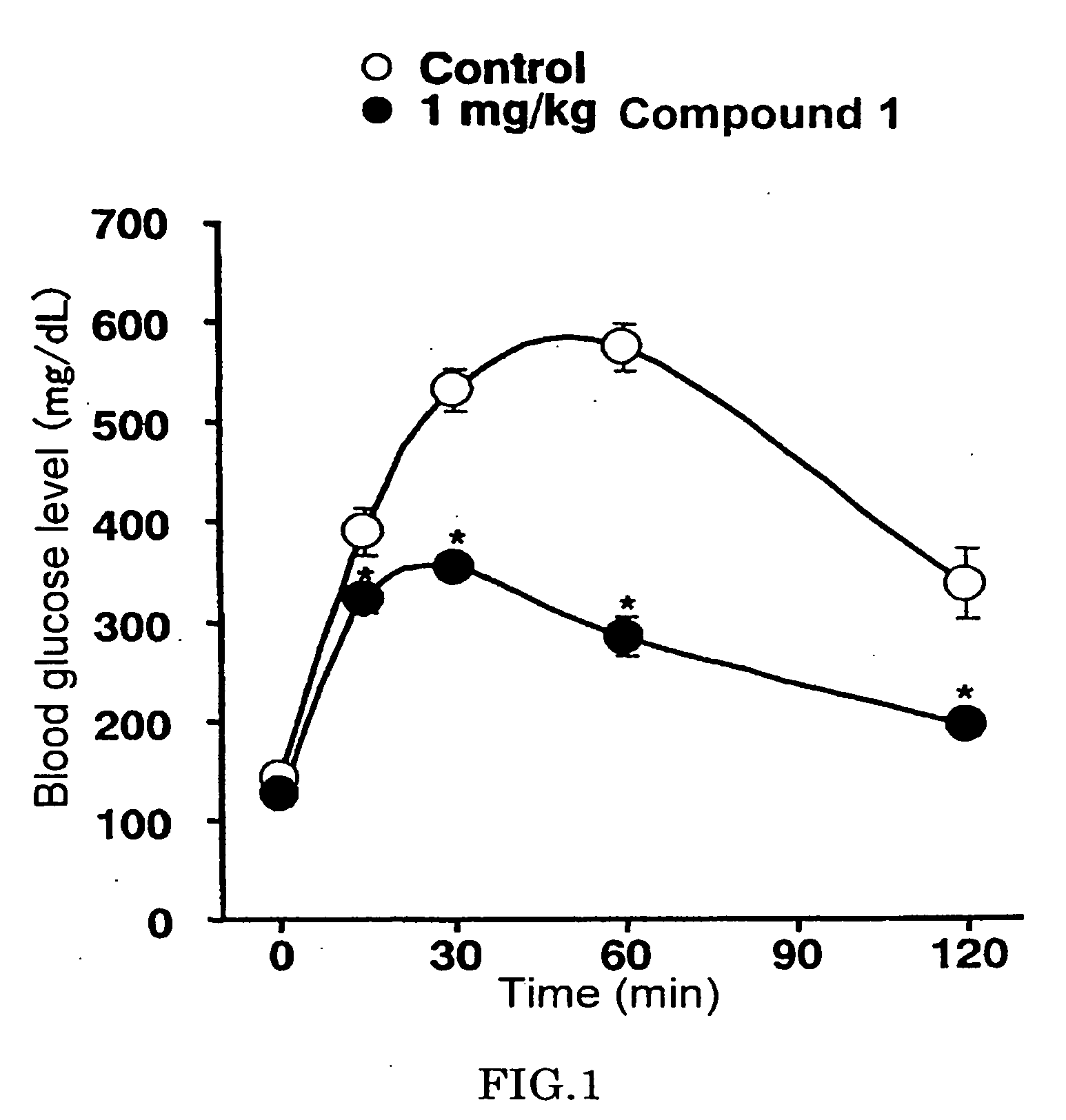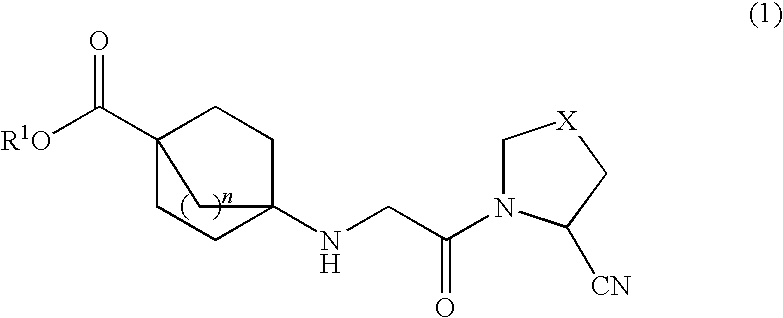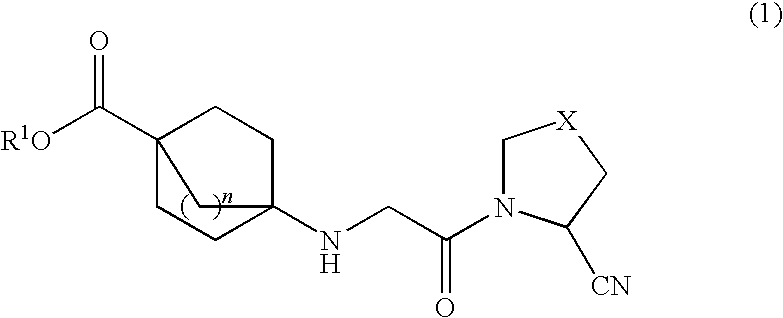Bicycloester derivative
a derivative and bicycloester technology, applied in the field of bicycloester derivatives, can solve the problems that none of the previously described dpp-iv inhibitors is practical enough in terms of dpp-iv inhibitory activity, and achieve the effect of high dpp-iv inhibitory activity, prevention and/or treatment of diabetes
- Summary
- Abstract
- Description
- Claims
- Application Information
AI Technical Summary
Benefits of technology
Problems solved by technology
Method used
Image
Examples
reference example 1
Synthesis of ethyl 4-aminobicyclo[2.2.2]octane-1-carboxylate
Step 1:
Synthesis of methyl 4-benzyloxycarbonylamino-bicyclo[2.2.2]octane-1-carboxylate
[0097]Methyl hydrogen bicyclo[2.2.2]octane-1,4-dicarboxylate (25.0 g), diphenylphosphoryl azide (32.5 g), triethylamine (17.3 mL) and toluene (500 mL) were mixed together. The mixture was stirred for 2 hours at room temperature and was heated and refluxed for 2 hours. To the resulting mixture, benzylalcohol (122 mL) was added and the mixture was further heated and refluxed for 17 hours. Subsequently, the mixture was allowed to cool and was sequentially washed with a 10% aqueous citric acid, saturated aqueous solution of sodium bicarbonate, and saturated brine. The mixture was then dried over anhydrous sodium sulfate and concentrated under reduced pressure. The residue was purified by silica gel column chromatography (eluant:hexane:ethyl acetate=2:1) to give methyl 4-benzyloxycarbonylaminobicyclo[2.2.2]octane-1-carboxylate (32.2 g).
[0098]M...
reference example 2
Synthesis of 1,1-dimethylethyl 4-aminobicyclo[2.2.2]octane-1-carboxylate
Step 1:
Synthesis of 1,1-dimethylethyl methyl bicyclo(2.2.2]octane-1,4-dicarboxylate
[0106]Methyl hydrogen bicyclo[2.2.2]octane-1,4-dicarboxylate (500 mg) was dissolved in dichloromethane (5 mL) and sulfuric acid (50 μL) was added to the solution. The mixture was bubbled with isobutene for 5 minutes while chilled in a salt / ice bath. The mixture was then stirred for 4 hours at room temperature and was left for 4 days. Subsequently, the reaction mixture was diluted with dichloromethane (5 mL), washed sequentially with a saturated aqueous solution of sodium bicarbonate and saturated brine, dried over anhydrous sodium sulfate, and concentrated under reduced pressure. The residue was dried under reduced pressure to give 1,1-dimethylethyl methyl bicyclo[2.2.2]octane-1,4-dicarboxylate (497 mg).
[0107]MS (FAB+) m / z: 269 (MH+).
Step 2:
Synthesis of 1,1-dimethylethyl hydrogen bicyclo[2.2.2]octane-1,4-dicarboxylate
[0108]1,1-Di...
reference example 3
Synthesis of 2-tetrahydropyranyl 4-aminobicyclo[2.2.2]octane-1-carboxylate
Step 1:
Synthesis of 2-tetrahydropyranyl 4-benzyloxycarbonylamino bicyclo[2.2.2]octane-1-carboxylate
[0114]4-Benzyloxycarbonylaminobicyclo[2.2.2]octane-1-carboxylic acid (1.00 g) was suspended in dichloromethane (10 mL). To this suspension, 3,4-dihydro-2H-pyran (1.20 mL) and then p-toluenesulfonic acid monohydrate (6.3 mg) were added and the mixture was stirred at room temperature for 30 minutes. Subsequently, the reaction mixture was sequentially washed with a saturated aqueous sodium bicarbonate solution and water, dried over anhydrous sodium sulfate, and concentrated under reduced pressure. The residue was purified by silica gel column chromatography (eluant:hexane:ethyl acetate=4:1) to give 2-tetrahydropyranyl 4-benzyloxycarbonylamino bicyclo[2.2.2]octane-1-carboxylate (1.18 g).
[0115]1H NMR (CDCl3) δ 1.53-1.95 (m, 18H), 3.67-3.71 (m, 1H), 3.82-3.89 (m, 1H), 4.59(br, 1H), 5.03 (s, 2H), 5.95 (br, 1H), 7.29-7.3...
PUM
| Property | Measurement | Unit |
|---|---|---|
| pH | aaaaa | aaaaa |
| temperature | aaaaa | aaaaa |
| pH | aaaaa | aaaaa |
Abstract
Description
Claims
Application Information
 Login to View More
Login to View More - R&D
- Intellectual Property
- Life Sciences
- Materials
- Tech Scout
- Unparalleled Data Quality
- Higher Quality Content
- 60% Fewer Hallucinations
Browse by: Latest US Patents, China's latest patents, Technical Efficacy Thesaurus, Application Domain, Technology Topic, Popular Technical Reports.
© 2025 PatSnap. All rights reserved.Legal|Privacy policy|Modern Slavery Act Transparency Statement|Sitemap|About US| Contact US: help@patsnap.com



